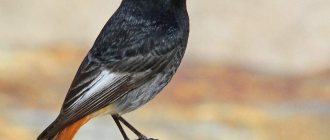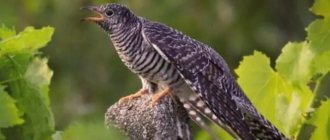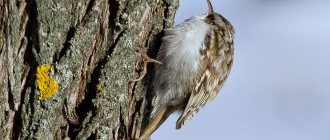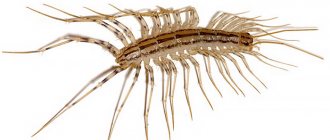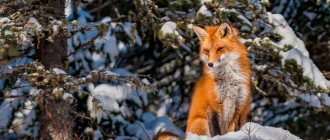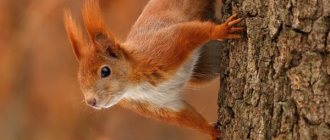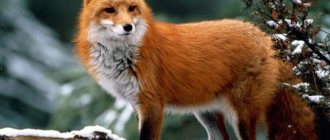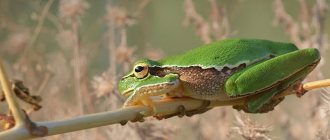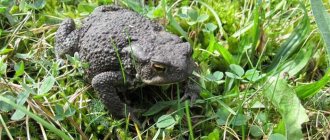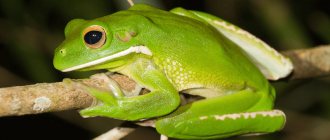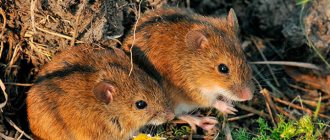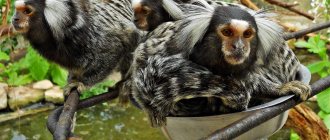Dipper - who is this? The dipper or water sparrow is a small bird from the passerine order, the dipper family. It is mentioned in children's stories and poems, but almost no one knows what this bird looks like. The brown dipper and the European dipper live in Russia. In our article we will provide general information about who the brown and European dipper are, interesting facts about the dipper and what species of bird still exist.
The dipper is a small graceful bird from the passerine order.
Appearance of a dipper
Many ornithologists agree that the dipper (water thrush) is the strangest representative of the passerine order. It is very small in size, the average height of individuals does not exceed 20 centimeters, and the weight does not even reach 100 grams, a maximum of 70–85 grams. Outwardly, it is very similar to a sparrow or blackbird, only more graceful.
The dipper has a funny tail, it is short and looks as if its tip had been chopped off. The bird's body is compact, with tightly pressed, rounded wings.
The color of the bird's feathers is dark, most often brownish (may differ in individuals of different species). The color of the breast and throat is white. This plumage helps the dipper to camouflage itself from its enemies in the summer. It seems as if the glare from the sun is reflected in the water, and not a bird jumping. However, not all species of the dipper family have white areas on their feathers.
The coloration of the dipper helps it camouflage itself from its ill-wishers.
A scaly pattern can be seen on the bird's body. In winter, the bird does not change its plumage, which makes it more vulnerable to enemies - on white snow, the brown dipper is easy to see from afar.
In young chicks, the plumage is closer to a gray shade; with age it becomes darker.
The dipper has very hard feathers, located tightly to each other. This prevents air from passing between them. In addition, she has a special coccygeal gland, which secretes a secretion to lubricate the feathers. This is necessary so that the dipper does not get wet when diving into icy water. The coccygeal gland of the dipper is several times larger than that of other waterfowl.
Under the feathers there is a layer of thick down that protects the dipper from even the most severe frosts.
The water sparrow has thin, fragile legs. Looking at the photo of the dipper, everyone is surprised how such legs can support such a dense body. The feet have four long toes, three of which point forward and one pointing back. They have sharp, tenacious claws, thanks to which the dipper can easily hold on to glaciers or rocks.
The dipper has thin, fragile legs with long, sharp claws
The bird has a funny beak, upturned and flattened on the sides. It is short, and there is no cere (a special skin thickening) at its base. This beak allows the bird to easily turn over pebbles in search of food. The nose has nostrils that are covered with special horny valves. The ears have the same structure. When a dipper dives into a body of water, these valves compress, protecting the ears and nose from water.
The tongue has bristles that help hold prey in the mouth.
THIS IS INTERESTING. The water sparrow has a special eye structure - a perfectly round lens and a flat cornea. This is how the bird maintains good vision under water.
How long do dippers live?
The lifespan of dippers depends on the species. On average they live no more than 5 years. But there are record-breaking centenarians who have lived for 7 years. Many birds die before reaching sexual maturity due to competition or external dangers in the wild. Thus, some chicks crash on rocks when they learn to fly.
Buzzard plumage color
While goshawks and sparrowhawks are easily recognizable by their typically variegated plumage on the front part of the body, honey beetles are characterized by strong color variability.
The back of the birds is usually gray-brown, sometimes with blurry dark spots and lines. The ventral part of the body is dark brown or almost white. On the light background of some individuals, transverse waviness is well expressed, while others, on the contrary, have dark vertical streaks. The pattern on the chest and abdomen of females is denser, which is why the ripples sometimes merge into a solid dark shield. At the base of the tail, 2 dark transverse stripes are clearly visible, one is located closer to the end.
Among the buzzards, there are completely brown, monochromatic individuals; these are mostly females; in males, the “hood” is usually visible to one degree or another - a dark gray crown and lateral parts of the head, contrasting with a light or variegated throat.
Young birds are also very different; there are dark brown individuals with light heads or entirely light-colored specimens. They do not have the “hood” characteristic of adult males, and their heads are covered with ocher-white streaks. The eyes of young birds are dull, gray or yellowish-gray.
Buzzard on the ground.
Buzzard
Buzzard
Types of dipper
Ornithologists distinguish five species of water sparrow:
- common dipper;
- brown dipper;
- American dipper;
- red-throated dipper;
- white-headed dipper.
The common dipper is widespread in Russia. It lives on the Kola Peninsula, in the foothills of the Caucasus, the Ural Mountains, and in Siberia. A small stocky bird of a dark shade. Her height rarely exceeds 20 centimeters, and her body weight hardly reaches 80 grams.
The common dipper is a small bird native to Russia.
The brown dipper in Russia is found only in the Far East. It can also be found in Japan, Korea, Indonesia, the Himalayas, eastern China, and on the coasts of the Yellow and Okhotsk Seas. The bird has brown or dark brown plumage without any inclusions or spots, a short tail, very stiff feathers, and thick down. The chicks have a marbled color. The lifestyle is predominantly sedentary; the bird does not go to warm regions for the winter. It can only fly to where there is an unfrozen body of water.
The brown dipper differs from the rest in the absence of a white spot on the chest
The American dipper lives in Central America and western North America. The bird is tiny - it reaches only 16–17 centimeters in length, and its weight is no more than 50 grams. The bird has white feathers on its eyelids. The color of the body is closer to gray, and the head is covered with brown feathers.
The red-throated dipper is found in South America, in the Andes, mainly in Argentina and Bolivia. It lives at altitudes up to 2500 meters. Considered a vulnerable species, there are about 3-4 thousand individuals. The whole body of the bird is gray, only the throat is red.
The white-headed dipper lives on the same continent as the red-throated one, only it can be found in a larger area of South America:
- in Peru;
- Ecuador;
- Bolivia;
- Venezuela;
- Colombia.
The color of the plumage is black, and the crown and breast are white.
The white-headed dipper lives only in South America
Geography of residence
Birds of the Snipe genus live throughout the entire globe except Australia and Antarctica. But the birds of the great snipe species nest in Eurasia; they can be found from the northern regions of Scandinavia to Eastern Siberia; in Central Europe the bird population is very small. In Asia, the population of great snipes is small; they are found in Palestine, Mesopotamia, and the birds have been recorded several times in India. A related species of bird with a similar name, the wood snipe, also lives in the CIS countries.
Great snipes are migratory birds; in autumn they begin their migration to Central and Southern Africa. In rare cases, they can winter in areas of the Mediterranean and the British Isles. They return to the nesting site during April - June.
Like all snipes, great snipes choose swampy areas for their residence, meadows with high humidity and low vegetation; they can also settle along a river bank overgrown with willow bushes or alders.
Showing great snipe.
The great snipe very rarely displays in the evening in the sun; most often all their battles took place after sunset.
Great snipe in the grass.
Great snipe with spread tail.
Where does the dipper live: range and habitat
The dipper prefers to settle near bodies of water. Preferably with such a fast current that the rivers do not freeze even in winter. It’s not for nothing that the bird is called a river diver. Therefore, most often it can be found on the banks of mountain rivers or streams.
The dipper prefers to settle near mountain rivers or streams with clean water.
Most dippers are found in Eurasia in the following areas:
- Russia;
- Norway;
- Finland;
- Asian countries;
- Scandinavian Peninsula;
- Caucasus;
- Iran.
There are many dippers in Ukraine, where they nest in the Carpathians, and in winter they fly en masse to the Ciscarpathian region.
In Ukraine, the dipper lives in the Carpathian Mountains
The dipper is a rare sight in Belarus, but in winter it can be found there, especially in the Vitebsk region.
In Russia, dippers are often found in the Leningrad region (usually in winter, but in the USSR cases of birds breeding in this territory have been recorded), the southern mountain ranges of Siberia and even in the Far East.
In the Sayan Mountains, the bird prefers to settle on the territory of the Sayano-Shushensky Nature Reserve. Moreover, in winter she chooses mountains with karst topography, since many rivers flow there, which originate from underground lakes. The water temperature in them can reach 10 degrees, these reservoirs never freeze, and you can always find food there. During the rest of the year, dippers are found on the banks of streams and rivers (including in the Yenisei water area) up to the tundra zone.
Many individuals of the dipper live on the territory of the Sayano-Shushensky Nature Reserve
On other continents, the dipper is rare, except in Africa in the Atlas Mountains and in the mountainous areas of Central and North America (the bird has even been seen in Alaska).
Many individuals live on the islands:
- Ireland;
- Great Britain;
- Sicily;
- Cyprus;
- Maine.
Migratory or resident bird
Most representatives of the dipper family lead a sedentary lifestyle, although some still prefer to fly to the southern regions for the winter, where it is warmer.
In winter, the dipper moves to unfrozen areas of water
Where does the dipper live in winter? It moves to those parts of rivers and streams that are not frozen. Sometimes it flies to flat areas, where it settles near rivers near polynyas.
Lifestyle Features
The common dipper prefers to nest far from human houses, so seeing its nests is very rare. The bird has a wide habitat radius; it can easily settle near fields or ponds.
The color of the bird allows it to be completely invisible in summer, and to move on land without much difficulty. These birds are very demanding about their permanent habitats. They need silence and comfort, so that there are not a large number of relatives nearby, and the birds settle at a distance of several meters among themselves. This behavior of birds is directly related to competition for food.
The Dipper constantly guards its territory, so it is almost impossible to fly into its nest. Birds usually lead a sedentary lifestyle. But there are also nomadic representatives who fly south for the winter and return back in early spring.
Dipper feeding a grown chick
Birds have two peaks of activity in their lifestyle: early morning and evening. The morning begins with a cheerful song and a search for food. During this period of the day, the bird prefers to hunt on land or in forests.
When evening comes, Dipper prefers to look for prey near bodies of water. Near the water element, she feels more free and there is a chance of a good catch. When night falls, the bird's hunting stops and it returns to its roosting site.
How do dippers reproduce and what kind of offspring do they produce?
It is almost impossible to distinguish a female dipper from a male; there are no differences between them in size or color.
Since the lifespan of the water sparrow is quite short, individuals reach sexual maturity in the first year. Their mating season begins in March. As soon as the severe frosts recede, you can hear the cheerful singing of dippers, indicating that they are ready to reproduce. Mating games last about two weeks, during which time the birds occupy territory to build a nest and breed offspring. They like to keep their distance, so each pair gets a territory of approximately 1.5–3 km².
The dipper's nest is made from branches, moss, algae, and leaves. According to some ornithologists, birds soak all dry materials in water before starting to build a nest.
Both partners are engaged in construction. They make a large nest - about 40 centimeters in diameter, round or cone-shaped, with a tube-shaped entrance. The entrance is always on the side where the pond is located. The house for future chicks is carefully camouflaged from enemies.
Dippers build their nests in hard-to-reach places
Birds try to build a nest near a pond. It happens that the dipper nests in tree hollows, but this happens rarely. Birds usually choose more inaccessible places:
- in rock gorges;
- in abandoned holes of wild animals;
- under bridges;
- on tree branches;
- on steep cliffs;
- between large stones.
Egg laying occurs around the beginning of April, usually the female lays 4–7 eggs. But most often two or three chicks hatch. There is very high humidity in the nest, so some of the eggs simply rot. There are cases when wild animals or birds completely destroy the nest and destroy the offspring, then the dippers nest again. It is rare, but dippers manage to breed two offspring during the summer.
The eggs of dippers are snow-white, without any inclusions, this is how they differ from the eggs of other passerines. The eggs are small, on average 20 millimeters.
The female is most often responsible for planting the eggs, but sometimes the male can replace her (some ornithologists believe that, after all, only the female is responsible for hatching the chicks).
Most often, the male simply stays next to his beloved, bringing her food and entertaining her with funny songs.
Dippers are good parents who will never leave their nest even in case of danger. Birds fight enemies who encroach on their offspring with the help of sharp long claws. They use them to scratch out the eyes of ill-wishers.
The chicks begin to hatch around the 18th–20th day. They peck through the shell and emerge into the world. Newborns are covered with thick gray-brown down, and have yellow, wide-open beaks. Both parents feed the chicks, bringing food directly to the nest. Feeding lasts about 20–25 days, after which the babies begin to learn how to get their own food. It is noteworthy that the chicks first learn to swim and only then fly. For swimming lessons, dippers choose reservoirs with relatively warm water so that the chicks do not die from hypothermia. Babies who cannot fly hide in crevices between rocks and in thickets under the strict supervision of their parents. But as soon as the chicks make their first timid flights, adult dippers drive them out of the nest. This is how adult life begins.
Reproduction
Birds become sexually mature at the age of 36-48 months. Terns are monogamous birds; most pairs remain for at least two seasons.
A common tern near a nest with a pair of eggs.
A Common Tern with a chick on its back and one egg hatching.
Common tern with two chicks: on the left, four days old; on the right, less than two days old.
Common tern family: the breadwinner has returned.
Feeding the chick of common terns.
Feeding an almost adult Common Tern chick.
Feeding an almost adult Common Tern chick.
Feeding the younger generation of Common Tern.
The mating ritual of the common tern is very unusual - the male rises and circles above the female, and upon landing, presents the female with a gift - a fish.
The photo shows that the terns' nest is a small depression in the ground lined with grass. At the end of April, 2-4 eggs of various colors appear in the tern’s nest. The parents zealously protect the nest from the air - in case of danger they dive at the enemy from a height. Both parents take turns incubating the eggs. After 20-22 days, the chicks are born; as soon as this happens, the parents take the shell away from the nest. In the first few days, the parents warm the chicks with their warmth and feed them up to 40 times a day. 21-28 days after birth, the chicks begin to fly; unfortunately, not all babies succeed in this - about 50% of the chicks die before they learn to fly.
Common terns can live up to 25 years, but only 10% of birds live to be 10 years old.
What does the dipper eat?
The dipper eats all living organisms that it can grab with its tiny beak:
- worms;
- dead insects that fall into the water;
- larvae;
- caviar;
- small fish fry;
- bugs;
- snails;
- caddisflies;
- small crustaceans.
In summer it is easy to get food - the bird walks along the river bank, jumping from stone to stone. There is a lot of food, you don’t even need to dive for it, all living creatures are found on the ground. Sometimes the dipper does enter the water - it does not disdain to feed on carrion and picks up drowned insects there.
The dipper feeds on small beetles, insects, and young fish
In extreme conditions, due to a lack of living organisms, the dipper can switch to plant foods, but the basis of its diet does not include grass and plants; it consists of insects and organisms living in water.
Many who have at least once observed a bird in winter ask why the dipper walks along the bottom? In winter it is much more difficult for her, the entire surface of the earth
covered with snow, and insects hibernated. It is then that the dipper has to use his skills, for which he is called a diver.
A dipper dives into icy water for food. The dipper in the water sinks to the very bottom, because there, at a depth, its food is found - larvae, various aquatic beetles and crustaceans. The bird can stay under water for a short time, less than a minute, then emerges. But the speed of movement is amazing - in such a short period of time the bird covers a distance of 20 meters underwater. On average, it descends to a depth of one meter, but sometimes, if it does not find its food there, it can dive even deeper. How does a dipper breathe under water? Her feathers help her with this. More precisely, grease on them. There is so much of it that air bubbles form in the water, which the dipper swallows, thereby replenishing its oxygen reserves. A small bird can resist the flow of even the fastest mountain river; the dipper skillfully chooses the correct body position. In order to go underwater, it accelerates in the air and then dives sharply, opening its wings so that they press it to the bottom. And when she needs to surface, she folds them back and rises from the depths.
Underwater, the dipper is almost impossible to notice
THIS IS INTERESTING. Soviet children's writer Vitaly Bianki, watching the dipper, did not hide his admiration. He was amazed at how this fragile, graceful bird dives into the icy water, and when it emerges, shakes itself off and, as if nothing had happened, sings a cheerful song. For this he called her a crazy bird in his stories and stories.
Natural enemies of the dipper in the wild
Since the dipper is small in size, it is a very vulnerable bird. She is constantly threatened by animals and birds that are larger than her. The greatest danger threatens dipper eggs, chicks and young individuals. Adults escape from enemies due to the fact that they are able to gain high speed and lie to the bottom. Having seen a predator, the bird strives to reach a reservoir, where it descends to the depths and waits for it to leave. This method is good to escape from other birds. And from terrestrial predators, dippers hide in crevices of rocks or mountains at high altitudes, where massive animals cannot reach. The chicks cannot boast of such agility, which is why they fall into the tenacious claws.
Seeing danger, the dipper is in no hurry to immediately run away from its habitat. She tries to escape from her ill-wisher by jumping from stone to stone. If the enemy continues to pursue her for about 500 meters, then she still flies away.
The natural enemies of dippers are considered to be:
- martens;
- cats;
- fox;
- ferrets;
- caresses;
- large birds of prey such as falcon, eagle, hawk and kite;
- rats and mice.
Marten is one of the main enemies of dippers.
Surprisingly, the greatest danger comes from the latter. Rats and mice, thanks to their dexterity and small size, easily sneak even into those nests of dippers that are hidden in narrow gorges and destroy them, destroying all the offspring. If the nest is destroyed, the dipper will never return to this place.
Answer or solution1
Dipper is an obnoxious underwater speedboat. A very interesting, nimble and dexterous bird, it cannot live without water. Not afraid of fairly fast and turbulent currents, the dipper, like an avid diver, dives into it and walks in it in search of its food - small crustaceans and insects. The bird swims and dives equally well, even perfectly. It leads a semi-aquatic lifestyle and, like all other birds, flies through the forest near its pond and sits on trees, therefore, it does not have gills, after all, a bird is not a fish. Walking along the bottom in this way, the bird obtains food for itself.
Do you know the answer?
How to write a good answer? How to write a good answer?
Be careful!
- Copying from other sites is prohibited. Stickers and gifts are not awarded for such answers. Use your knowledge.
